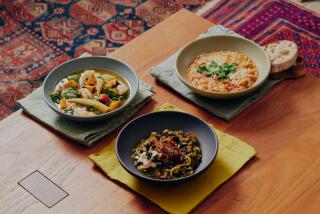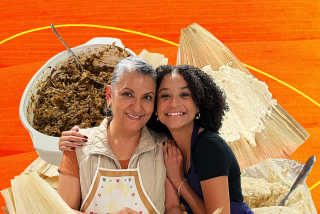The Son Also Fusses
My 6-year-old son Farrell will eat the occasional bowl of chicken noodle soup for dinner, with salad on the side. He prefers a basic oil-and-vinegar dressing. He will abide no herbs, and will tolerate no fresh ground pepper whatsoever. He isn’t interested in sliced tomatoes or cucumbers. Just lettuce, please.
On the other hand, his preferred dinner (as basic as his peanut butter and jam--not jelly--sandwich for lunch) consists of noodles sprinkled with grated Parmesan cheese and steamed broccoli on the side. If beets are pickled, he will eat them, but not otherwise. He is currently in favor of fettuccine noodles, though I did notice the last time we were in the market he slipped a box of shell-shaped noodles into the cart.
I have given up yanking my hair for better ideas. I have tried them all. We talk about it. Every once in a while he will feel sorry for me and suggest that if I were to cook white chicken meat, he would eat it cold the next day. If I bake him a potato and scoop out the skin, he will eat the skin and then pick away at the potato. Sometimes he will deign to eat a small piece of salmon, but only if I serve it with his grandmother’s (my mother’s) barbecue sauce--and then only rarely.
He calls his grandmother “Nana,” which, if I read my Peter Pan right, is the name of a dog. I have never approved. He calls his maternal grandmother “Mormor,” in the Swedish fashion. I assured my mother that she shouldn’t feel slighted, since “Farmor” is Swedish for paternal grandmother, which she certainly is.
I will say this much for Farrell: He pretty much gives everything a try. Always has. I was just the opposite, something I recall each time he shoves an entire flower of broccoli into his mouth, munching away without concern. My mother could never have gotten me to do that. Not even on Mother’s Day.
I can’t say I carry around a long list of favorite food memories or cooking techniques garnered at the knees of my mother in her kitchen. My food range was extremely narrow. When I found an appealing dish, I tended to stick with it--Franco-American spaghetti when I was sick, for instance, though that was reheating, not cooking. I went through the usual peanut-butter-and-jelly-for-lunch phase. But that gave way to several years of clam chowder made with a can of minced clams. And that gave way to my mother’s version of Welsh rarebit served over salted soda crackers.
Though she has now largely abandoned the kitchen, my mother was a good cook, though not a great cook. Part of her goodness was her willingness to try new foods, to be inventive, regardless of the outcome. At one time in the late ‘50s she suddenly started producing Japanese dishes, probably inspired by Sunset magazine and our cleaning woman at the time. Though miso soup and a savory custard would remain in the family food oeuvre , the cellophane noodles fell as flat as a bad joke.
I became a bit more aware of how good I had it at home when my parents flew off to South America for a month, which is a long, long time for a little tyke, particularly one with highly defined food displeasures.
I went to stay with the Morrisons and learned soon enough that even though I didn’t care for eggs--in fact, I didn’t eat them at all, and didn’t learn to enjoy them until my 16th year--there they were on my plate and I had better eat up. A test of wills, if you will. I remember laying the eggs on top of the toast, then slathering them with as much jam as I could scoop out of the jar. And then I choked them down.
I looked back fondly on those eggs the night the family was served liver in a cream sauce with dumplings, the thought of which still makes me gag. In that month I no doubt added to the gray in Ken and Marion Morrison’s hair, for which I can now publicly apologize.
My mother never would have pushed the point. She did try from time to time to get me to eat baked squash, probably because she knew I would like the nutty flavor mixing with butter and brown sugar. But it was no go. I was old enough by then to realize that I was being silly, but I had laid down my gauntlet so long before that I couldn’t very well pick it up without losing face. And a child’s face is so small, there isn’t much there to lose.
What my mother cooked was invariably made with fresh ingredients, this in the face of the post-war food processing that caught so many cooks’ attention. The closest we got to TV dinners was the very occasional frozen chicken pot pie, and even that didn’t last long.
There was always fresh fruit galore--citrus, bananas, a box of Jonathan apples in the carport every fall, pears, melons. In fall too were bowls of nuts--walnuts, Brazil nuts, almonds, hazelnuts. The only rule of consumption was that the empty shells went into the garbage sack, not back into the bowl.
The day began with the sound of my mother padding down the hall, then downstairs to the kitchen. She was the one to brave the cold house and turn on the furnace. My brother and sister and I, and my father, would follow after.
My mother believed in fruit at the breakfast table. In melon season, that meant cantaloupe, a quarter section each. When the blueberries in the yard were ripe, she would go out in her Stewart tartan bathrobe to pick a bowl to add to cereal or pancakes. She carried a long-shanked screwdriver on these forays and stabbed slugs on the lawn on her way out and on her way back, stacking them up the shank. She would pause by the back door, lift up the garbage can lid, scrape the screwdriver clean on the edge of the can, and make her deposit. It would be years before I realized that not all mothers did this sort of thing.
When the first juicy oranges hit the market, she would serve those at breakfast. But she didn’t just quarter them, which was sufficient for lunch. She peeled and sliced them and laid them out in neat, overlapping circles on a platter, and then sprinkled them with powdered sugar, which would be half-dissolved by the time we reached the table.
But her greatest achievement was the grapefruit. I am always astonished at people who think nothing of digging away at a grapefruit with a spoon. My mother was one to carefully slice each section free of its membrane so that eating grapefruit at breakfast was a simple, civilized affair.
When I do this for myself with half a grapefruit I never overlook what it must have been like for her to do it five times over. I would never go so far a to call my mother a patient woman, so something else must have been at play as she worked through one grapefruit half after another. Love, perhaps?
I can’t say that love was a thing of wildly open expression in our household, of breast pounding and exhortation. Yet, our house was filled with love. And I know now how much of it came to me through the food I was served as a child.
I wouldn’t begin to truly eat and enjoy food until I landed in India at age 20 and discovered how far away and unavailable were the food comforts I associated with home. It was a matter of eat or starve in India, which lead to a miraculous explosion of culinary possibilities and pleasures. My mother had accomplished much the same with Welsh rarebit on salted soda crackers.
As I aged and she aged, I came to understand that while cooking was all well and good, it wasn’t something in which she took great pleasure. As she and my father moved from one domicile to another, she would winnow out her cooking tools.
In her last move, to a retirement complex in San Diego, I was asked if I wanted the Mixmaster or the pressure cooker. She extolled with what sounded like great relief the joys of a tiny service kitchen.
Residents of the complex dine together. Where for years she had served in the home kitchen, putting out one nutritious meal after another even though she may well have wanted to do something else, forever bringing new food ideas to the table in the face of a child who for most of his life at home ate within an extremely limited range, she can now say she has retired, and sit down to eat. When she comes to visit, I do the cooking.
When Farrell tells me he really isn’t interested in my making him a pizza, no matter what I leave out, nor a light tomato sauce for his noodles, nor a hamburger-laced taco, nor a nice lentil soup, nor scalloped potatoes, I don’t push the point. If my mother taught me anything, it’s that what’s on the plate is love. Eat what you want. Save room for dessert.
More to Read
Eat your way across L.A.
Get our weekly Tasting Notes newsletter for reviews, news and more.
You may occasionally receive promotional content from the Los Angeles Times.










